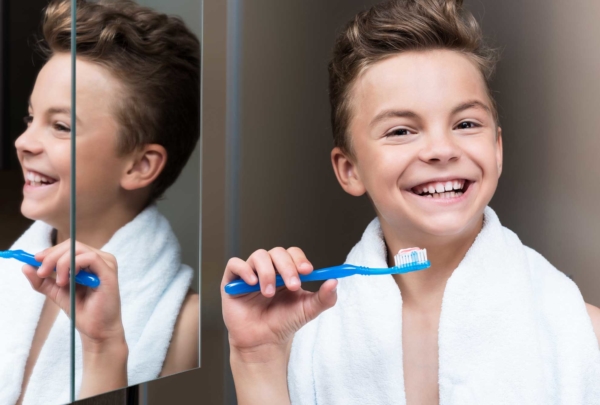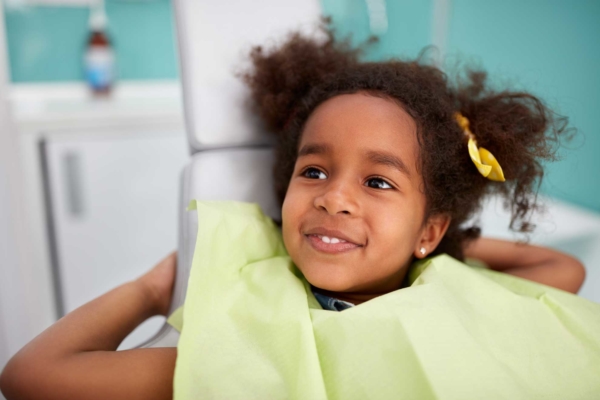Children’s Dentistry
CHILDREN’S DENTISTRY INFORMATION
Dental sealants are protective coatings applied to teeth that are at risk of decay. Although tooth decay in children has decreased, preventable decay still occurs. Combined with drinking fluoridated tap water and using a toothpaste with fluoride, sealants will virtually eliminate decay in the permanent teeth of many children. Sealants are safe and painless.
Get your child to brush their teeth every day from around 18 months of age. This will encourage a habit of brushing teeth. You will need to help your child brush until they are old enough to do it themselves, usually around the age of six to seven years. Encourage your child to spit out, not swallow, toothpaste.

TEACHING YOUR CHILDREN TO BRUSH:
Teaching Childern how to brush – mother and childYour child’s teeth should be brushed twice each day – after breakfast and before going to bed at night. Start by brushing your child’s teeth for them.
- Place the child in a position so that they feel secure
- Sit your child on your lap, facing away from you
- Cup their chin with one hand, with their head resting against your body
- Clean their teeth as you would your own, brushing the tooth and gum line
- Children should be encouraged to brush their own teeth as they get older but you will need to help them for several years until you are sure they can do it themselves
THE RIGHT TOOTHBRUSH & TOOTHPASTE
Variety of toothbrushesChoose a toothbrush that is designed for children. It should have a small head and soft bristles. Your child should use a children’s low-dose fluoride toothpaste from 18 months to six years of age, unless specified by an oral health professional. Children who do not drink fluoridated water or who are at high risk of developing dental decay may need to vary the type of toothpaste used based on dental professional advice.
HOW TO BRUSH
- Smear a pea size amount over the toothbrush.
- Always brush in a circular motion, cleaning a few teeth at a time.
- Be sure to brush the gums along the gum line and to clean all tooth surfaces.
- It is best to spit out toothpaste rather than swallow it. This can be difficult for small children, you will need to encourage and show them how to do it.
TIPS TO ENCOURAGE TOOTHBRUSHING
Not all children will enjoy brushing their teeth at first. Here are some tips to encourage tooth brushing:
- Make it fun
- Keep it quick
- Children like to imitate others, so let them brush with other family members who can help them
- If your child objects to the taste of toothpaste, try brushing without toothpaste. Introduce a children’s low dose fluoride toothpaste when the child accepts the taste
- If you are not having any success in the bathroom, try the kitchen
- Give younger children a toothbrush as a toy
- Use a reward system to encourage older children. For example, mark the number of times their teeth are cleaned each week on the calendar and offer rewards for achievements
- The development of the primary teeth begins while the baby is in the womb. At about five weeks’ gestation, the first buds of primary teeth appear in the baby’s jaws. At birth, the baby has a full set of 20 primary teeth (10 in the upper jaw, 10 in the lower jaw) hidden within the gums. Primary teeth are also known as baby teeth, milk teeth or deciduous teeth.

TOOTH TYPES
Each type of tooth is named for ease of identification, including:
- Incisors – are the front teeth located in the upper and lower jaws. Each incisor has a thin cutting edge. The upper and lower incisors come together like a pair of scissors to cut the food.
- Canines – are the pointy ‘vampire’ teeth, on both sides of the incisors in the upper and lower jaws. They are used to tear food.
- Premolars – have flat surfaces to crush food.
- Molars – are larger than premolars. These teeth have broad, flat surfaces that grind food.
ERUPTION OF PRIMARY TEETH
The term ‘eruption’ refers to the tooth breaking through the gum line. In babies, tooth eruption is also called teething. The timing of tooth eruption differs from child to child. For example, one child may cut their first tooth when only a few months old, while another may not start teething until they are 12 months old or more. While the timing may vary, the order of tooth eruption is generally the same. This includes:
- The two front teeth (central incisors) in the lower jaw are usually the first to erupt. This occurs somewhere between the ages of six and 10 months.
- The two front teeth (central incisors) in the upper jaw erupt between the ages of eight and 13 months.
- The lateral incisors, which are the teeth on each side of the central incisors, erupt in both the upper and lower jaws between the ages of eight and 16 months. The lower set tends to erupt before the upper set.
- The first set of upper and lower molars (flat-surfaced back teeth) erupt between the ages of 13 and 19 months.
- Canine or ‘eye’ teeth sit beside the lateral incisors and erupt in both the upper and lower jaws between the ages of 16 and 23 months.
- The second set of upper and lower molars erupts between the ages of 25 and 33 months.
- Generally, the average child has their full set of 20 primary teeth by the age of three years.
LOSS OF PRIMARY TEETH
Between the ages of about six and seven years, the primary teeth start to shed. The central and lateral incisors in the upper and lower jaws are usually the first to go. Some children may worry about the loss of their first teeth, but the tooth fairy, with her cash reward for every shed tooth, usually helps to ease anxiety.
ERUPTION OF PERMANENT TEETH
Group of childrenPermanent teeth are also known as adult teeth or secondary teeth. The permanent teeth start to develop in the jaws after a child is born. By about 21 years, the average person has 32 permanent teeth, including 16 in the upper jaw and 16 in the lower jaw. (In some cases, however, the third molars – commonly called wisdom teeth – do not develop. Consequently, a set of 28 permanent teeth is considered normal too.
At about the age of six years, the first permanent teeth erupt. These four molars (two in the upper jaw and two in the lower jaw) emerge behind the child’s existing primary teeth. Other permanent teeth, such as the incisors and canines, erupt into the gaps in the gum left by shed primary teeth.
Like primary teeth, the timing for when the permanent teeth come through differs from one child to the next. Generally, the order of eruption and rough timeline for each type of permanent tooth includes:
- First molars – between six and seven years
- Central incisors – between six and eight years
- Lateral incisors – between seven and eight years
- Canine teeth – between nine and 13 years
- Premolars – between nine and 13 years
- Second molars – between 11 and 13 years
- Third molars (wisdom teeth) – between the ages of 17 and 21 years, if at all
